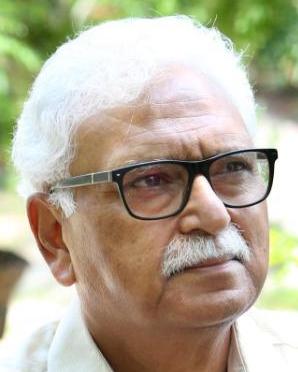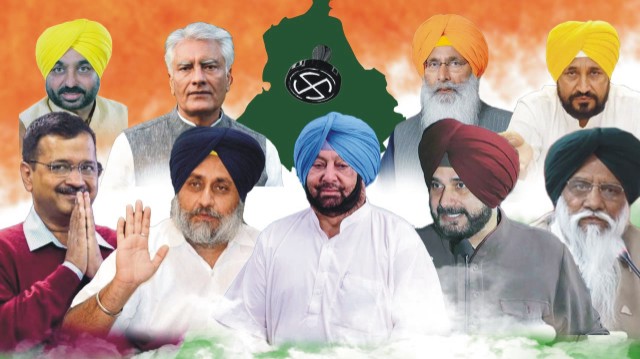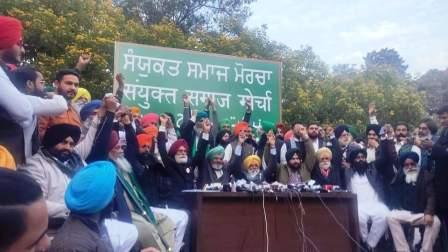

The release of the film ‘83’ on India team’s victory over the mighty West Indies team to win its first ever World Cup in 1983, helped recall a moment that turned out to be very significant.
 No one had expected India to enter the finals, much less win the Cup. Even half of the players had booked themselves for a visit to the US after the first couple of matches. Then something happened with boosted their morale.
No one had expected India to enter the finals, much less win the Cup. Even half of the players had booked themselves for a visit to the US after the first couple of matches. Then something happened with boosted their morale.
The team’s very first match in the preliminary round with the almost invincible West Indies was a stunner. Indian team did the unthinkable and actually won that match !
The psychological impact that it had on the team was reflected in the World Cup final with the same team which, as the world knows, won the Cup.
The ensuing Assembly elections in Punjab have nothing to do with the Cricket World Cup but one can take a leaf or two out of the book on how the morale can make a difference.
Past record shows that the outcome of the Municipal Corporation elections in Chandigarh, the joint capital of Punjab and Haryana, has no impact on the Assembly elections which follow a little later in Punjab.
This time, however, there is an important takeaway from the Corporation elections held a couple of months before the Assembly elections in Punjab. The Aam Aadmi Party (AAP) emerged as the largest party for the first time in any elections outside Delhi.
The party, which is making a determined attempt to wrest power in Punjab, has received a major boost, as the Indian cricket team did in 1983, with its cadres gaining confidence that it can win elections outside the national capital.
It is another matter that the BJP, which had finished a close second, was able to elect its Mayor with the Congress and the lone Akali counsellor deciding to abstain from the polling for the post of Mayor.
Another important factor in the Corporation elections was the multiplicity of contests. Besides the ruling Bharatiya Janata Party, the Congress, the AAP, the Shiromani Akali Dal (SAD), a large number of independents in the fray had made it a multi-cornered contest with comparatively small number of electors in each ward. In at least five wards the margin of victory was only in double digits.
 The coming elections in Punjab too are set to be multi-cornered contests with the emergence of the alliance between Capt Amarinder Singh and BJP, the SAD-BSP alliance, the Congress, the AAP and now also the Sanyukt Samaj Morcha formed by farmers organisations, besides the independents.
The coming elections in Punjab too are set to be multi-cornered contests with the emergence of the alliance between Capt Amarinder Singh and BJP, the SAD-BSP alliance, the Congress, the AAP and now also the Sanyukt Samaj Morcha formed by farmers organisations, besides the independents.
The current possibility of 5-cornered contests would definitely leave the field wide open with various parties eating into each other’s vote banks and making the task of predicting the outcome a near impossibility.
It is in this context that an analysis of the past electoral trends would be significant and relevant to the ensuing elections.
For over three decades, Punjab had witnessed a straight contest between the SAD and the Congress. This changed last time when the AAP entered the fray and changed the political equations. Several electoral surveys had predicted an AAP victory given the disenchantment with the other two political parties.
The Congress emerged victorious with a thumping majority of 77 seats out of a total of 117 at stake thanks to a large extent to the division of votes in the three-cornered contest. SAD won 15 seats (besides three by its alliance partner BJP) against the tally of 20 for the AAP and two for its alliance partner.
But what’s significant is that the SAD finished second in no less than 43 seats while AAP finished second only in 26 seats. Akalis got lesser number of seats than AAP but received more votes.
SAD got 25.3 per cent of the total votes polled as against AAP’s 23.8 per cent. Add to that the 5.4 per cent votes polled by the then SAD’s alliance partner, the BJP. They together polled 37 per cent votes against 38.5 per cent by Congress.
Akalis contested on 94 seats compared to 112 by AAP and still got 1.5 per cent higher vote share than AAP. Same is true for Congress. Both in 2007 and 2012 when it lost elections to the SAD-BJP combine, Congress posted a vote share of over 40 per cent.
It is in this context that the pre-poll scenario needs to be analysed with five-cornered contests on the anvil.
 The ruling Congress, which rocked its own boat by changing the chief minister just six months before the elections, is facing an internal crisis. Its unpredictable state party chief Navjot Singh Sidhu continues to take potshots at the party’s own government and chief minister Charanjit Singh Channi.
The ruling Congress, which rocked its own boat by changing the chief minister just six months before the elections, is facing an internal crisis. Its unpredictable state party chief Navjot Singh Sidhu continues to take potshots at the party’s own government and chief minister Charanjit Singh Channi.
In the given short time the new chief minister is coming out with a flurry of announcements which lack credibility while some of the sitting legislators are quitting the party anticipating denial of tickets.
Even as the 56-member election committee supposed to send its recommendations to the party high command for final selection of candidates yet to meet, Sidhu has been declaring candidates for some of the seats. The party is also yet to develop a strategy for the elections.
SAD, which had quit the coalition with BJP over the farm laws, has tied up with the Bahujan Samaj Party (BSP) whose vote share has been less than two per cent even though one third of the state’s voters belong to the Dalit Samaj.

However, Akalis are by far the first movers. Party chief Sukhbir Singh Badal has been actively leading the party and besides the alliance with the BSP, has already declared candidates for the ensuing elections in Punjab.
SAD is also attempting to woo back its core constituency of rural votes by touting that it has quit the coalition and power to stand behind the farmers.
The party is not facing any major hostility from farmers now and its fate would depend on how rural voters view its role in the aftermath of the farm laws which were subsequently withdrawn.
AAP, which had built up a strong cadre before the last elections, lost some ground with several leaders quitting the party and the state unit of the party remaining disoriented over the last four years. It has received a fillip after the Chandigarh Municipal Corporation elections but continues to remain under the direct charge of its central leaders.
It’s biggest failing has been a lack of a credible chief ministerial face. With just over a month left for the elections, the party chief Arvind Kejriwal has decided to maintain silence over the issue although he has declared that the candidate would be a Sikh from Punjab. This effectively ruled himself out of the race as was being apprehended last time.
The new entrant to the political scenario, the Sanyukt Samaj Morcha (SSM), might turn out to be the X factor in the coming elections. About 22 of the farmers organisations, which had led the farmers agitation, have joined hands to form the party although some others have decided to stay away from entering politics.
 On its own, the new party is unlikely to make a serious dent but it can change the calculations if it decides to tie up with one of the major parties as multi cornered contests would lead to smaller margins of victory.
On its own, the new party is unlikely to make a serious dent but it can change the calculations if it decides to tie up with one of the major parties as multi cornered contests would lead to smaller margins of victory.
Even in the previous elections nearly 20 seats had witnessed very narrow victory margins. And if SSM joins hands with AAP, which has a strong presence in urban areas, it would be a strong alliance to be reckoned with.
The latest reports, however, are that major differences have emerged between the AAP and the SSM. One of the leading SSM leader, Ruldu Singh Mansa said on Friday that the talks between the two have failed because AAP was fielding those rejected by other parties.
Either way the role of the SSM would have to be watched closely and would be crucial for the final election outcome in Punjab.
Even as the model code of conduct has come into force and schedule announced for elections next month, the political situation remains fluid with new alignments in the making and finalisation of party tickets setting the tone for the Punjab assembly elections. ![]()
_____________
Also Read:
Centre’s Opaque Auction Rules For Pulses Rip Off Govt Coffers, Help Millers Strike Rich
Need to amend laws like UAPA to provide for punishment for those who slap false cases
Global Arms Trade: Who are the real winners?
Why not 40 pc tickets for women in Punjab and elsewhere?
Punjab – How a deadly cocktail of Agri-Water-Energy nexus going to destroy it?
North Pole and the ideological conflict of RSS & Hindutva
Politics of Symbolism: Dalit Chief Ministers in India

Disclaimer : PunjabTodayTV.com and other platforms of the Punjab Today group strive to include views and opinions from across the entire spectrum, but by no means do we agree with everything we publish. Our efforts and editorial choices consistently underscore our authors’ right to the freedom of speech. However, it should be clear to all readers that individual authors are responsible for the information, ideas or opinions in their articles, and very often, these do not reflect the views of PunjabTodayTV.com or other platforms of the group. Punjab Today does not assume any responsibility or liability for the views of authors whose work appears here.
Punjab Today believes in serious, engaging, narrative journalism at a time when mainstream media houses seem to have given up on long-form writing and news television has blurred or altogether erased the lines between news and slapstick entertainment. We at Punjab Today believe that readers such as yourself appreciate cerebral journalism, and would like you to hold us against the best international industry standards. Brickbats are welcome even more than bouquets, though an occasional pat on the back is always encouraging. Good journalism can be a lifeline in these uncertain times worldwide. You can support us in myriad ways. To begin with, by spreading word about us and forwarding this reportage. Stay engaged.
— Team PT


Copyright © Punjab Today TV : All right Reserve 2016 - 2025 |